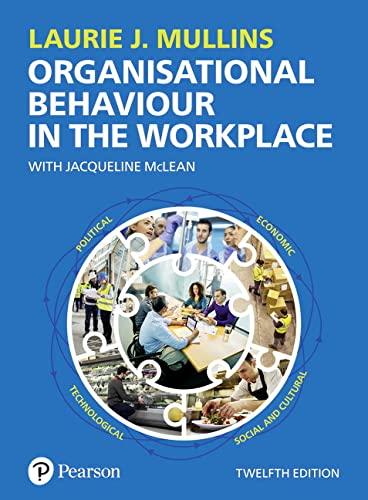Question
A Leadership and Workforce Development Perspective. The literature review should discuss the related literature, organized by topic or themes (not a list of sources). A
A Leadership and Workforce Development Perspective. The literature review should discuss the related literature, organized by topic or themes (not a list of sources). A literature review includes synthesis, analysis, and critique of scholarly articles, textbooks, doctrinal manuals, or other sources. A literature review typically contains the following sections: Cover/Title page, Body/Content, and List of references. Provide a conclusion for your literature review. This section indicates what you discovered during the literature review on the topic and identifies any themes you may have uncovered throughout the literature. Research Topic The manufacturing industry plays a vital role in the global economy, supplying essential products and services to consumers across different sectors. However, the industry faces significant challenges in attracting and retaining skilled workers, particularly during the COVID-19 pandemic, which has disrupted supply chains and accelerated the adoption of automation and digital technologies. As a result, there is a growing need for leaders and managers in the manufacturing industry to adopt innovative strategies to address recruitment challenges, develop their workforce, and remain competitive in a rapidly changing environment. Recruiting skilled workers in the manufacturing industry has become a critical issue that requires a concerted effort from leaders and managers to address the shortage of skilled labor, leverage technology, and develop effective training programs to attract and keep talent. This capstone paper aims to explore the critical issue of recruitment in the manufacturing industry and propose effective leadership and workforce development solutions to address this challenge. Research Problem The manufacturing industry transforms goods, materials, or substances into new products. The transformational process can be physical, chemical, or mechanical (Levinson, 2018). Manufacturing industries rely heavily on a labor force able to fulfill the job requirements necessary to finish the product. There has been a significant issue with employers in the manufacturing industry recruiting experienced or trainable personnel to fill vacant positions within their companies. The shortage of skilled workers in the manufacturing industry is a pressing issue that requires urgent attention from leaders and managers. The situation within the manufacturing industry, characterized by an aging workforce, the adoption of new technologies, and the COVID-19 pandemic, has created a shortage of skilled labor. This problem has created the following situation: Many manufacturers need help filling job openings, which has resulted in production delays, increased costs, and decreased competitiveness. According to the National Association of Manufacturers Q4 2022 survey, 76% of manufacturing leaders listed attracting and retaining a quality workforce as a primary business challenge likely to worsen in the coming years. This problem affects the manufacturing industry and the broader economy because it limits growth, productivity, and innovation. Since the Covid-19 pandemic, companies have changed how they would typically do business. The pandemic affected every type of business in some way. However, the manufacturing industry was also under some unique circumstances. These circumstances included supply chain disruptions, an economic recession, vulnerabilities in cyber security, patent infringement liability, and widespread worker illness (Dwyer, 2020). To address this problem, leaders and managers must adopt a multifaceted approach that includes leveraging technology, developing effective training programs, and collaborating with educational institutions and policymakers. Research Questions Even after a global pandemic that saw the global economy plummet and workers lose jobs, manufacturing industries have had difficulties filling job vacancies post-pandemic. According to Deichler (2021), manufacturers will need to rethink their approach to hiring if they want to attract talent throughout the current decade and beyond. There are currently over 500,000 jobs in the US manufacturing industries unfilled and expected to be over 2.1 million jobs open by 2030 (Deichler, 2021). The research question for this study is: What leadership and workforce development strategies can leaders and managers in the manufacturing industry adopt to address the shortage of skilled labor and remain competitive in a rapidly changing environment? How does the manufacturing industry fill these jobs? What must the manufacturing industries do to attract potential candidates to their organizations while providing upward career progression to current employees and management training? These questions will be the focus of this CAPSTONE paper to understand the factors affecting recruitment challenges in the manufacturing industries and help to find ways to address the issues through leadership and workforce development. The paper should have in-text citations and a reference page with a list of references and the URL link for the source.
Step by Step Solution
There are 3 Steps involved in it
Step: 1
To construct a literature review on leadership and workforce development in the context of the manufacturing industry youll need to organize your content effectively around key themes and topics relat...
Get Instant Access to Expert-Tailored Solutions
See step-by-step solutions with expert insights and AI powered tools for academic success
Step: 2

Step: 3

Ace Your Homework with AI
Get the answers you need in no time with our AI-driven, step-by-step assistance
Get Started


